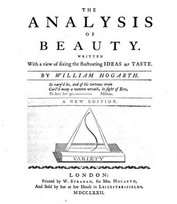 The first three plates in the Universal System of Household Furniture, the directory published by Ince & Mayhew between 1759 and 1762, contain Ornaments for Practice and include instructions for novice designers on how to draw. The first plate includes the following description: Plate I – containing several pieces of Foliage properly adapted to young beginners in their first practice of Drawing, being extremely necessary to bring the Hand into that Freedom required in all kind of Ornament, useful to Carvers, Cabinet-Makers, Chasers, Engravers, etc, etc. …. The next plate is called A Sistimatical Order of Raffle Leaf from the Line of Beauty and is described as a compleat Leaf of Foliage; the principal Sweep or Centre Line is that Foundation and Basis of the whole Order of Ornament; that must be first drawn and made perfect (which can only be done by freedom of Hand) before you proceed any further; It was interesting to learn from an article in the RIHA Journal[i], that William Hogarth was promoting the theory of the line of beauty in his book Analysis of Beauty which was published in 1753. He saw the line of beauty as an S-shape, or an inverted S-shape, which he considered conveyed liveliness and activity, which would excite the viewer. This was in contrast to straight lines, which were seen as inanimate. It is interesting to see William Ince used the phrase Line of Beauty and it would seem likely that Hogarth’s book was important to him when learning his trade. His apprenticeship with John West started in 1753, so the book would have just been available. Incidentally a raffle leaf was an architectural ornament. The Dictionary of Architecture and Landscape Architecture’s definition is: Serrated, indented, or crumpled leaf-like enrichment with waving indented frond-like (or raffled) edges. Raffling is applied to the notched edges of carved foliage in architectural ornament. I have also discovered that the Universal System of Household Furniture was not known to have been advertised in America until 1766. An advertisement appeared in the South-Carolina & American General Gazette (Charleston) on July 18, 1766. It read: “Robert Wells, At the Great Stationary and Book Shop on the Bay, has imported for sale Chippendale’s and Ince and Mayhew’s designs of household furniture from London.” The advertisement appeared again in 1772.[ii] [i] Anne Puetz, Drawing from Fancy: The Intersection of Art and Design in Mid-Eighteenth-Century London RIHA Journal [ii] Morrison H. Heckscher, English Furniture Pattern Books in Eighteenth-Century America http://www.chipstone.org/article.php/48/American-Furniture-1994/English-Furniture-Pattern-Books-in-Eighteenth-Century-America (Dixon, p.68, no.19). |
Author
Sarah Ingle is the great great great great grand-daughter of William Ince and has been researching her family history for a number of years. She thoroughly enjoyed the detective work involved in tracing William’s lineage. Archives
December 2022
Categories |

 RSS Feed
RSS Feed